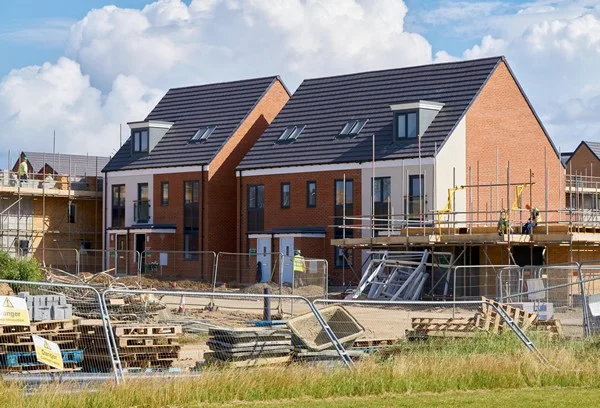News
High Street Mortgage Rates Hit New Sub-1% Low as Competition Heats Up
The mortgage battle being fought by the UK’s biggest lenders is heating up, with advertised rates having dipped as low as 0.83% with some banks. There are now numerous deals being advertised with introductory rates of less than 0.9%, with HSBC having broken its own long-standing records with a product up for grabs at just 0.89%.
Elsewhere, Halifax has a market-leading two-year introductory deal available at 0.83%, coupled with a standard £999 arrangement fee.
All the ultra-affordable products available at these kinds of lows are open only to those able to offer a deposit of 40%. Decent offers are available for mortgages with lower down payment requirements, but they do not come close to rivalling these all-time High Street lows.
How low will mortgage rates fall?
Analysts have been debating for some time exactly how low mortgage rates could fall before the beginning of an inevitable return to norms. Experts are split evenly down the middle, with half suggesting they could easily go lower than 0.5% and the other half saying the deals available right now are as good as they are going to get.
Brokers are urging those who are fast approaching the end of their introductory rate mortgage deal to consider switching now before being automatically transitioned to a standard variable rate product. There is a chance for a vast audience of mortgage payers to save many thousands of pounds by taking advantage of the opportunity while it is available.
One of the reasons for these record-low mortgage rates is the fact that the Bank of England base rate is still sitting at 0.1%, where it is likely to remain for some time. The housing market in general has seen record activity over the past few months, with demand having consistently outstripped supply in all regions of the country.
This has prompted lenders to introduce increasingly generous incentives to potential applicants in order to give them a competitive edge over rival lenders.
Competitive deals with lower down payments
For applicants able to pull together a deposit of 25% to 30%, there are deals available that are edging close to the 1% mark. HSBC has a 75% LTV mortgage available with a 1.19% introductory interest rate and an arrangement fee of £999.
Mortgages with a deposit requirement of 15% are still competitive, typically hovering around the 1.8% mark with similar arrangement fees. For buyers looking to take out a 90% LTV loan, there is a significant shift in average rates from around 2.2% to 2.5% or more. Some deals for 10% mortgages are hovering around the 2.9% mark, though with additional incentives such as low arrangement fees and up to £500 cashback with some lenders.
Applicants are therefore advised to consider the total costs associated with taking out a mortgage rather than focusing exclusively on the initial low APR.
Mortgage Payers Advised to Switch to Save Thousands
Experts are advising homeowners approaching the end of their two-year fixed-rate periods to consider switching to a new deal rather than automatically transitioning to their lender’s SVR (standard variable rate).
According to Moneyfacts.co.uk, the average mortgage payer could save an average of 1.93% on their mortgage payments by taking action at the opportune moment.
Data suggests that while the average two-year fixed mortgage rate was 2.53% in July 2018, today’s average SVR is around 4.46%. Consequently, those who allow their loans to be automatically switched to the lender’s SVR can expect an average increase in their mortgage repayments of 1.93%.
This would mean that for a mortgage payer with an outstanding balance of £250,000 and 23 years left on their term, their monthly repayments would be £1,449.99 on an SVR mortgage of 4.46%.
Moneyfacts.co.uk reports that two-year fixed-rate loans are today being offered at an average of 2.05%, a full 2.41% less than today’s average SVR. This would therefore mean that if the same homeowner above switched to a 2.05% two-year fixed rate deal, they would face a much lower monthly repayment of £1,136.82.
This would subsequently save them £313.17 per month, amounting to a huge £3,758.04 saving over the course of a year.
A temporary window for significant savings
While there is still plenty of scope for homeowners to make huge savings by switching at the right time, market movement suggests the window may be closing. Two-year fixed rates are slowly but steadily rising, gradually eroding the savings that could be made by switching at the opportune moment.
“With the average SVR likely to remain more static moving forward and the mortgage market itself remaining fluid, as lenders continue to amend their ranges in reaction to an ever-evolving landscape, there is no guarantee that rates will not continue to increase,” commented Eleanor Williams, a finance expert at Moneyfacts.co.uk.
“However, as there remains an almost 2.50% difference between the average SVR and the average two-year fixed rate today, the benefits of switching speak for themselves, as being able to save significantly on monthly outgoings could be more important than ever in these uncertain times.”
“Those who wish to explore whether they are able to reduce their rate and consequently their monthly mortgage payment would do well to move swiftly.”
“As with any financial commitment, seeking advice from an independent, qualified adviser has never been more relevant, as understanding the true cost of any new deal, taking into account any fees and incentives, and indeed keeping up-to-date on the available products and criteria could be made significantly easier with assistance from a professional.”
New Campaign Seeks to Support Rejected Mortgage Applicants
Major high-street banks are being urged to offer more support to mortgage applicants whose applications are likely to be rejected. A new initiative called “Thanks for Nothing” has been launched by specialist mortgage platform with the aim of preventing rejected applicants from becoming trapped in ongoing rejection cycles.
Hayton voiced concern that major banks and lenders are not providing nearly the kind of support first-time buyers need to get on the property ladder in the UK. On up to 50% of the platforms, customers said that their mortgage applications had been declined by at least one other lender or broker.
This initiative could prove particularly useful for applicants with a poor credit history and the self-employed, who, despite being able to comfortably afford a mortgage in most cases, are often automatically declined.
“Self-employment and poor credit histories are on the rise in the UK, so a growing number of people applying for mortgages simply don’t fit the traditional financial mould,” said Paul Cos, co-founder of Hayton.
“Many are being rejected by traditional lenders and online mortgage brokers that can’t see past their situation, while others will be put off from applying at all.”
Rejected applicants are discouraged from reapplying
A survey conducted by the mortgage experts at Bluestone in 2019 found that almost half of all declined mortgage applicants are discouraged from reapplying with other lenders. The survey also found that comparatively few subsequently seek the input of independent brokers or advisers.
In the wake of three consecutive lockdowns, market watchers expect declined mortgage application volumes to continue growing for the indefinite future.
Speaking on behalf of Bluestone Mortgages, CEO Steve Seal commented on the extent to which the coronavirus crisis has intensified economic uncertainty for many households.
“Covid-19 has left people in financial difficulty, and as a result, many will emerge from the Covid-19 pandemic with more complex borrowing needs,” he said.
“We have already seen evidence of this, with our application volumes in January and February 2021 increasing by 90% compared to the same period in 2020.”
“We anticipate this trend to continue over the coming years as borrowers navigate the fallout of the pandemic and increasingly approach lenders who can support them with affordable financing.”
More applicants declined by major banks
Bluestone also reported that around 37% of mortgage brokers have found that most cases that involve referring clients to specialist lenders are attributed to application rejections from major high-street banks. This represents a major uptick from the 29% recorded last year.
It was determined that 68% of application refusals are based on poor credit, 28% on adverse credit, and 22% on regular income streams. 18% of application refusals resulted from CJJs, according to the data from Bluestone.
UK Bridging Sector Maintains Momentum Throughout Q2
The UK’s bridging finance sector held steady throughout Q2, achieving modest growth on Q1’s impressive overall performance. According to the latest Bridging Trends report from MT Finance, total bridging activity during the second quarter increased to £146.5 million from £144.5 million in the first quarter.
The report indicated that the vast majority of lending activity taking place during the quarter was made up of first-charge loans. MT Finance revealed that 90% of total market volume was made up by first-charge lending activity, an increase of more than 12% from the previous quarter.
The period’s impressive performance was credited in part to the number of landlords and investors looking to take advantage of the temporary stamp duty holiday. Investment property purchases remained the number-one application for bridging finance, accounting for almost 25% of all loans issued.
Chain break accounted for around 20% of all transactions, making it the second most popular bridging finance application during the period.
The report also indicated that the average bridging loan terms for Q2 were around 12 months, which is the same as the previous quarter.
The commercial director at MT Finance, Gareth Lewis, indicated no real surprise at the sector’s strong performance this year so far.
“As purchases would have been at the top of people’s minds due to the stamp duty saving, it’s no surprise to see that first charge lending has significantly increased its share of transactional volumes,” he said.
“It will be interesting to see if this percentage decreases in the coming months as consumers look to raise financing out of existing properties to fund further property acquisitions or businesses.”
Evidence of growing confidence in the UK property market
His sentiments were echoed by Chris Whitney, head of specialist lending at Enness, who commented on the generally positive outlook for the sector going forward.
“It looks like we have reached quite a stable platform over the last two quarters. Any previous pandemic worries seem to have been put to one side with the stamp duty holiday deadline, creating a frenzy of activity. The higher level of investment purchases shows confidence in the UK property market is strong,” he said.
“I am slightly surprised that lending volumes weren’t higher. The market certainly felt very busy as we struggled to get values out in a timely manner due to volumes, and many a solicitor had to burn the midnight oil to keep up with demand.”
Meanwhile, bridging and development finance specialist for Brightstar Financial, Stephen Watts, spoke of the significance of lenders and brokers streamlining application processes to reduce loan completion times.
“Some lenders are now offering automated valuation models up to 75 percent loan to value (LTV) in some circumstances, and with the ability for asset managers to benefit from modern technology and carry out virtual client meetings, more loan applications are benefiting from these time-saving factors,” he said.
Meanwhile, bridging and development finance specialist for Brightstar Financial, Stephen Watts, spoke of the significance of lenders and brokers streamlining application processes to reduce loan completion times.
“Some lenders are now offering automated valuation models up to 75 per cent loan to value (LTV) in some circumstances and with the ability for asset managers to benefit from modern technology and carry out virtual client meetings, more loan applications are benefitting from these time-saving factors,” he said.
The 1% Mortgage is Back, but what does it Really Mean?
Competition among lenders on the High Street is fuelling an unprecedented and escalating price war; over the course of the last month, several lenders have once again introduced sub-1% two-year fixed mortgage deals for the first time in years.
Today there are at least 10 two-year fixed remortgage deals being advertised at rates of less than 1%, all of which are prompting many to ask the obvious question:
Are 1% mortgage rates for real, or is it all too good to be true?
Why lenders are offering sub-1% mortgage deals
The motivation for offering mortgages with interest rates lower than 1% is fairly straightforward. As things stand right now, lenders are finding themselves with little choice but to go to extremes to get new customers on their books.
Competition between lenders is fierce, meaning many are throwing out the kinds of deals they would never have considered in previous years.
“The sub-1% mortgages to surface have grabbed the spotlight as lenders drop their rates to bring in new business after the market endured an unsettled period due to the pandemic,” explains Rachel Springall, finance expert at Moneyfacts.co.uk.
“Genuinely, a deal with a low rate and high fee may only be suitable for someone with a substantial mortgage who can meet the eligibility criteria. If borrowers were to approach a mortgage broker and assess the deal based on true cost, they may well find they are better off elsewhere on a deal with a slightly higher rate but with a more reasonable fee and incentive package. It really does depend on their circumstances and what they are looking to borrow, so seeking advice is wise.”
“There is much more scope for lenders to cut pricing in the higher loan-to-value sectors, but we have only recently seen product choice grow in this area of the market, after a significant drop due to the pandemic.”
“With this in mind, it may be a few weeks before lenders consider slashing their rates on higher loan-to-value mortgages, and instead they may well just maintain their presence in the market or make minor tweaks for borrowers who have been waiting for deals to return.”
A competitive offer with caveats
The appeal of a sub-1% mortgage deal is undeniable, but it is unlikely that most prospective buyers will be able to qualify for such rates. With the vast majority of lenders offering sub-1% deals, including NatWest, Royal Bank of Scotland, TSB, and Platform, the maximum LTV available is just 60%.
In order to qualify, the applicant would subsequently need to provide a minimum deposit of 40% along with all other initial charges. The offer is therefore unlikely to appeal to most first-time buyers, for whom saving the minimum deposit requirement is often the biggest of all barriers to homeownership.
In the meantime, movers and first-time buyers looking to get the best possible deal are advised to consult with an independent broker rather than approaching any specific lender directly. Some of the most competitive deals on the market are available exclusively in the form of broker-introduced applications and are not available on the High Street.
Build-to-Let: A Brief Overview
In the UK the typical approach to generating long-term revenues from a rental property has been buy-to-let investments, this is where an individual or organisation invests in an existing property in order to let it out to prospective tenants as a landlord.
With affordable inventory becoming increasingly thin on the ground, alternative options are being explored by new and established investors alike. One of which is build-to-let investment opportunities, which call for an entirely different form of finance.
What Is Build-to-Let?
As the name suggests, build-to-let refers to a development project wherein residential dwellings are built with the goal of being let out to tenants. A specialist type of development finance product, build-to-let funding is available exclusively on projects that result in the creation of three or more residential units.
These units can be flats, houses and other types of residential dwellings, which may be created in the form of refurbishments, property conversions or new builds.
Where specialist build-to-let finance is available, it is typically offered in the form of three different types of products:
- Residential finance– available for the development of most types of residential dwellings, including flats, houses, student accommodation and Houses in Multiple Occupation (HMO).
- Commercial finance– offered for the development of business premises and office spaces, along with storage facilities, factories and general commercial units.
- Mixed-use finance– issued for projects involving the development of properties to be used for multiple purposes, such as a combined commercial and residential property.
Build-to-let finance is typically issued primarily on the basis of the property’s estimated value upon completion. As with all secured borrowing facilities, the lender has the right to repossess and sell the property to recoup their capital if the borrower is unable to repay the loan as agreed.
What Are the Potential Advantages of Build-to-Let Finance?
The main advantage of build-to-let finance is the way in which it is a fully made-for-purpose solution for these kinds of investments. All aspects of the loan are engineered with the requirements of build-to-let investors in mind.
Build-to-let finance is often available over a much longer term than many comparable short-term development finance products; this provides the investor with greater flexibility in regard to subsequently repaying the loan over a number of years.
In terms of LTV, a typical lender will provide build-to-let of anything from 60% to 75% of the property’s value, this therefore means an initial deposit requirement of around 25% is needed, which may be negotiable depending on the lender in question.
Build-to-let loan values can be exponentially higher than those of many comparable secured lending products; depending on the requirements of the project and the financial circumstances of the applicant, build-to-let loans are available from £1 million to £10 million or more.
Independent Broker Support
As there are comparatively few lenders in the UK who specialise in build-to-let finance, independent broker support is essential.
For more information on any of the above or to discuss your requirements in more detail, contact a member of the team at UK Property Finance today
Bridging Loans: A Lifeline for Homebuyers
Defying all projections, the UK’s property market has enjoyed a stellar year; average house prices have broken all records, monthly sale completions are at an all-time high and demand continues to outstrip supply in all regions of the UK.
Competition for desirable properties has become ferocious on an unprecedented level. Consequently, those who encounter delays or disruptions during the purchase process are often finding themselves being beaten to the punch by rival buyers.
With demand at an all-time high, lenders are finding themselves with inevitable backlogs and bottlenecks to deal with. Mortgage completion times have been on the up for much of the past year, making it difficult for would-be buyers to take advantage of time-critical opportunities.
One of the many reasons why bridging loans have become a popular choice for homeowners is because it is a flexible and cost-effective option for preventing their property purchases from falling through.
Bridging Loans for Faster Property Purchases
To put the benefits of bridging finance into context, consider this typical everyday example:
You have been scouring the market for a new home when you find your dream property at an unbeatable price. It is well within your budget, but you have not yet found a buyer for your current home. This is where bridging finance can help, it can be secured against your current home and repaid in full when you sell it.
Bridging loan completion times typically average just two weeks. The loan is secured against your current home, providing the fast-access funds you need to buy your new property, after which the loan is repaid in full a few months later using the proceeds raised from selling your former home.
With monthly interest rates starting from less than 0.5%, bridging loans can be far more affordable than any comparable loan or mortgage.
The same benefits also come into play in the event of a home sale that falls through at the last minute. It could be that you have a buyer lined up for your home and everything seems to be in place, only for them to pull out unexpectedly at the worst possible time.
Rather than such a scenario costing you your dream home, an affordable bridging loan could be used to buy your new property.
A Reliable Exit Strategy
As bridging finance is designed to be repaid as quickly as possible, it should only be considered with a reliable exit strategy in place. If you are 100% confident that your current home will be successfully sold within a few months, the facility could be surprisingly affordable.
Bridging finance is not a viable option for long-term borrowing; monthly interest rates of less than 0.5% are highly competitive in the short-term, but could prove costly if the loan remains unpaid for some time.
If interested in using a bridging loan to help you purchase your dream home, we can help. Contact a member of the team at UK Property Finance anytime for an obligation-free consultation.
Why July 1st Was Not Necessarily Stamp Duty Doomsday
The July 1st stamp duty deadline was seen as a black mark on the calendar by many prospective homebuyers. As of this date, the full stamp duty holiday officially came to an end, having been extended from its initial March 31 deadline.
Consequently, thousands rushed the completion of their property purchases to take advantage of potential savings of up to £15,000. But what many may not realise is that there is still a good degree of tax relief available for a sizeable proportion of prospective homebuyers.
Understanding the changes
The original stamp duty holiday, introduced last year in June, eliminated stamp duty liability for buyers of properties valued at £500,000 or less. Prior to this, the threshold had stood at just £125,000.
As of July 1, the £500,000 nil band threshold was decreased to £250,000. This will now remain in place until the end of September, during which all purchases of properties valued at £250,000 or less will be exempt from stamp duty.
This means that there are still significant savings to be made for the vast majority of home buyers in many regions of the country. Savings worth many thousands of pounds could, to a small extent, augment the skyrocketing costs of buying a home in the UK.
Alterations to stamp duty obligations
As of July 1, the thresholds that applied during the stamp duty holiday were reduced slightly, meaning the following rates now apply:
- £0-£250,000 = 0%
- £250,001-£925,000 = 5%
- £925,001-£1,500,000 = 10%
- £1,500,000+ = 12%
When the September 30 deadline passes and the stamp duty holiday is withdrawn entirely, the same rates as prior to the pandemic will apply:
- £0-£125,000 = 0%
- £125,001-£250,000 = 2%
- £250,001-£925,000 = 5%
- £925,000-£1,500,000 = 10%
- £1,500,000+ = 12%
However, there will still be significant savings available to first-time buyers. Anyone looking to purchase a home for the first time with a value of £300,000 or less will be exempt from stamp duty entirely. For properties valued between £300,001 and £500,000, 5% of the subsequent portion between these amounts will be payable at the time of purchase.
This therefore means that stamp duty liability will remain zero for most first-time buyers in England and Northern Ireland.
Competitive mortgage deals continue
Along with significant savings on stamp duty, highly competitive mortgage deals continue to motivate first-time buyers. Specifically, the widespread availability of 10% and 5% deposit mortgages is encouraging more prospective buyers to make their moves.
The number of 95% LTV products on the market has increased by more than 100% over the past two months. There are now approximately 192 5% mortgage products available on the High Street, up from just 80 in May.
Elsewhere, some lenders are offering fixed-rate mortgages with a 40% deposit requirement and interest rates as low as 1%. Interest rates on higher LTV mortgages are also lower than they have been in some time, but buyers unable to provide more than a 5% deposit are being heavily scrutinised with regard to their financial circumstances and credit history.








